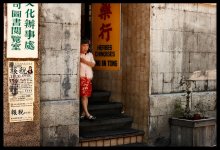This is really the point, isn't it?
At the end of the day, your film is ending up being converted to binary code, just like any digi camera. And just like any digi camera, the world of digital workflow and editing is limited only by an individuals knowledge and taste. The problem with shooting film and digitizing is there's a huge bottle neck at the scanner end. Even outsourced pro scans, unless you've got a great relationship with a technician, are hit and miss because tastes and skill levels vary.
These days I pretty much exclusively shoot with my Mamiya 7ii. Through a loop, the trannies look like God him/herself. The scans however are clearly worse, when scanned on my V700, than 35mm trannies scanned on my Nikon Coolscan. They're okay for proofing and small book work, but if you choose to shoot MF, you really want a quality jump up from 35mm to justify the extra money, bulk and time. My M8 files we're better than V700 MF scans considering they gave a more forgiving starting point for editing and we're sharp out of the camera and not degraded during a scanning process. My limited skill working with DNG / Raw files were the problem, not the files themselves.
I've just bought a glass holder for a Nikon 9000 scanner I have access to at work. The scans I'm getting using that from my M7ii trannies are truely stunning and finally the results justify the medium format upgrade.
My honest opinion is I love the process of shooting and especially editing film. I think the M7ii is brilliant quality, clearly better in my experience than 35mm film or digi if scanned well, but the M8, and in fact any good digital camera, has an important place to fill. Like Jaap said, who wants to print that large and spend that much time and money scanning and editing all the time? If I didn't have access to a 9000ED I'd seriously consider getting rid of my 7ii, and I think that's the point of this thread, isn't it? The M8 is certainly good enough, if not overkill, for most situations that don't require you to print huge mural size images.



